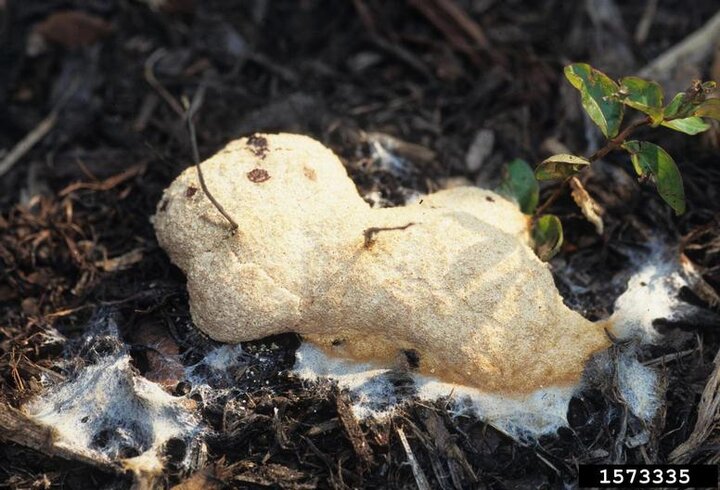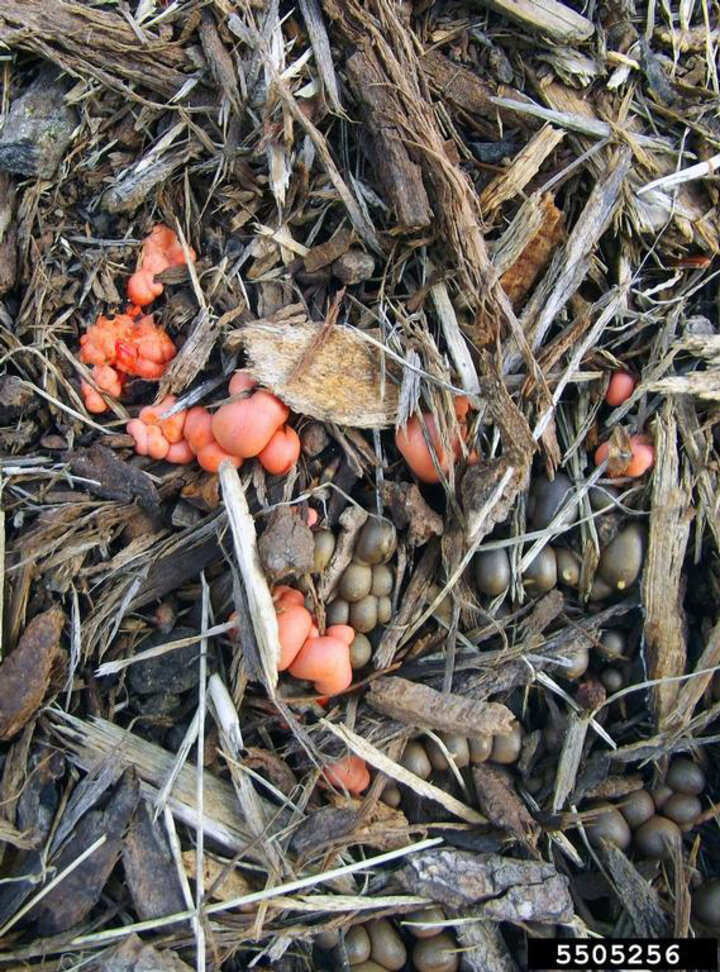Sarah Browning, Nebraska Extension Educator

Dog vomit slime mold. Image by Jason Sharman, Vitalitree, Bugwood.org
Slime molds are interesting and unusual organisms which frequently appear in landscapes and on the blades of turfgrass. When gardeners call Nebraska Extension for help, usually the call goes something like this, "There is something on the mulch in my flower beds. It looks like a dog vomited, but I know that can't be right because my yard is fenced and I don't have a dog. Can you help me figure out what it is?"
Or the question might be, "I have patches of dark gray fungus growing in my grass. How can I get rid of it before it kills my grass?"
Both of these questions point pretty clearly, for a horticulturist or plant pathologist, to slime mold.

What is a Slime Mold
Slime molds are really interesting! At one time they were classified as primitive fungi, but are now classified botanically outside the fungi kingdom. They have been placed in the kingdom Amoebozoa, which means they are more similar to an amoeba than a true mushroom.
A slime mold begins its life by germinating from a spore, similar to a fungus, into a cell that can move. Cells swim through the water on the surface of leaf blades or pieces of mulch, and fuse together to form large masses. The slime mold exists as one cell, called a plasmodium, made up of many nuclei all held together in one large cytoplasm bag. Some plasmodia can grow quite large, like a large pizza, while others are small, about the size of a pinhead. Most often, slime molds found in mulch are intermediate in size, about 4-5 inches across.
It grows by feeding on bacteria, fungal spores, and organic matter such as dead leaves and wood. It feeds by surrounding its food and secreting enzymes to digest it. Dead turfgrass leaf blades and thatch provide a good supply of organic matter for slime mold growth.
Slime molds get their name from one of their life stages, in which the plasmodium is a slimy, wet mass. This is the feeding stage of the slime mold and is mobile, moving up to several feet a day. One slime mold, Fuligo septica, resembles wet peanut butter when at this stage. The plasmodium can be many colors- white, yellow, gray and shades of red.

When environmental conditions become hot or dry, this mass dries out and hardens.
A recent caller described this stage of a slime mold in their landscape, as looking like dried expandable foam insulation. If wet conditions return, the wet slime mold stage returns and feeding continues. When the food source is exhausted, the mass again dries out and enters a stage of spore production. Spores may remain dormant in soil or leaf litter for many years until conditions are right for growth.
What Does This Mean for My Landscape?
Ok, so you have a slime mold growing in your mulch. What should you do? Break it up and wash it into the soil with water. Or scoop the mass out of the mulch and place it in the trash.
What if it's growing on your grass? Slime mold uses turf leaf blades as a surface for growth, but do not damage the grass at all. Rake the area to knock the growth off leaf blades, or use a strong stream of water to remove it. Fungicide applications are not necessary or recommended.
But be sure to take a moment to appreciate the slime mold for its uniqueness, before you get rid of it!
Images:
- Dog vomit slime mold As the slime mold dries and matures, it becomes brittle and dark spores form just beneath the surface. Image by Gerald Holmes, Strawberry Center, Cal Poly San Luis Obispo, Bugwood.org.
- Slime mold - Immature (pink) and maturing (brown) aethalia or "fruiting bodies" of the slime mold commonly called the wolf's milk slime mold on mulch. Image by Sandra Jensen, Cornell University, Bugwood.org.
Search Our Archive
Associated Video
Mushrooms In The Landscape
Nebraska Extension Plant Diagnostician Kyle Broderick talks about how fungus and mushrooms form in the landscape and turf, and offers suggestions on how to control them.